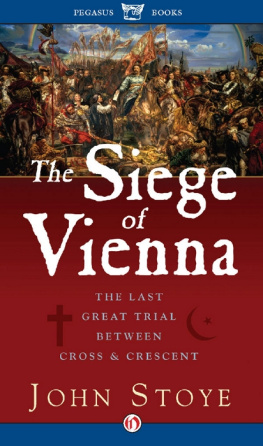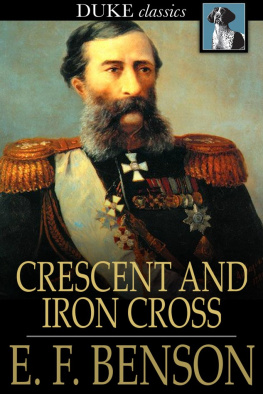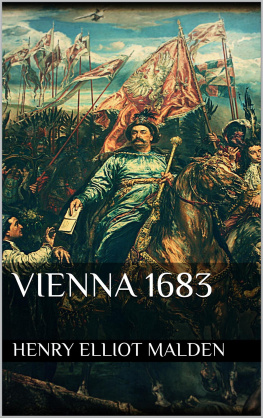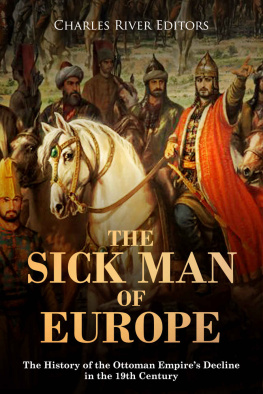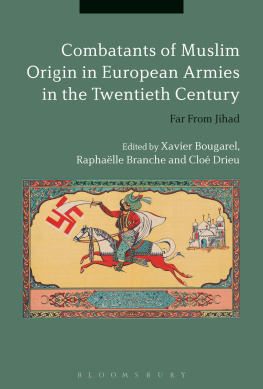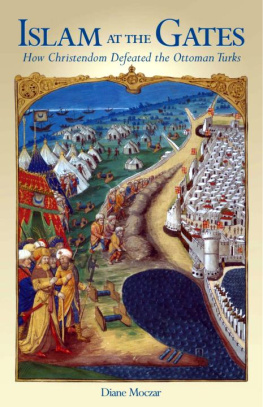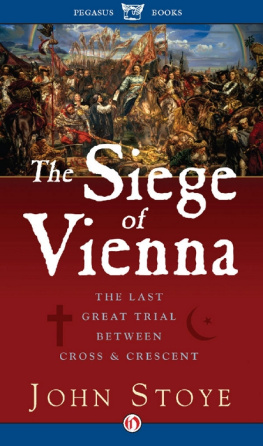
The Siege of
VIENNA
The Last Great Trial Between
Cross & Crescent
John Stoye

PEGASUS BOOKS
NEW YORK
Illustrations
The Ottoman Frontier: Esztergom and Neuhusel
From pen-and-ink sketches by Dr Edward Browne in Additional MS. 5233 of the British Library
The Habsburg Frontier: Komdrom and Petronell
Engravings by G. Bodenehr and C. Beutler
Emperor Leopold I
By Michel Nol, drawn in Frankfurt in 1658, and by Elias Heiss
Charles V Duke of Lorraine
Engraved by J. C. Sartorius in 1677
The Burgplatz in Vienna
From the painting by Samuel Hoogstraten, dated 1652
The Hofburg and the Turkish Siege-Works
Drawn by Daniel Suttinger in 1683, and here reproduced from Vienna Gloriosa, id est peraccurata & ordinata Descriptio (Vienna, 1703)
Vienna in the Seventeenth Century
From engravings in E. Francisci, Vor-Blitz dessfortstralenden Adler-Blitzes... und zu Beleuchtung des jetzo wtenden trckischen- und frantzsischen Waffen dienlichster Vorbericht (Frankfurt, 1691)
Tartars and their Prisoners Crossing a River
From L. F. Marsigli, Ltat militaire de lempire ottoman, ses progrs et sa dcadence (The Hague, 1732)
The Siege at its Height
Drawn by Daniel Suttinger in 1687 and engraved by M. Bodenehr in 1688
Koltschitzki in Disguise
Frontispiece to Das heldenmthige wiewol gefhrliche Unterfangen Herrn Georg Frantzen Koltschitzky (Nuremberg, 1683)
The Danube and the Wiener Wald
Engravings by M. Merian, in his Topographia Provinciarum Austriacarum (Frankfurt, 1649), and by an unnamed artist
The City of Passau
An engraving dated 1576, by L. Abent
Starhemberg
Engraved by L. Gomier, and published in Rome
Sobieski
Published by C. Allardt in Amsterdam
An English Broadsheet, 1684
The original is printed in red ink
The following authorities have kindly given permission for the reproduction of these plates: The Trustees of the British Library for nos. IIV, VI, VII, IXXI and XIVXV, the Kunsthistorisches Museum, Vienna, for no. V, the Curators of the Bodleian Library for no. viii, and the Ashmolean Museum for nos. XII-XIII
Maps and Plans
Eastern Europe in 1683
The Danube in 1683
Germany in 1679
The Fortification of the City
Tartar Raids in Austria, 1683
The Routes to Vienna, JulyAugust 1683
The Wiener Wald, September 1683
Some of the
Principal Personages
Mehmed IV, Sultan
Kara Mustafa, Grand Vezir
Michael Apafi, Prince of Transylvania
Serban Cantacuzene, Prince of Wallachia
George III Duka, Prince of Moldavia
Murad Ghiraj, Khan of the Crimea
Imre Thkly, King of Hungary
Louis XIV, King of France
John III Sobieski, King of Poland
Charles XI, King of Sweden
Leopold I, Emperor
Eleanor of Pfalz-Neuburg, Empress, Leopolds third wife
Eleanor of Mantua, Dowager Empress, Leopolds step-mother
Eleanor, Leopolds half-sister, who married Charles Duke of Lorraine
Frederick William, Elector of Brandenburg
John George III, Elector of Saxony
Max Emmanuel, Elector of Bavaria
Charles V, Duke of Lorraine
Herman, Margrave of Baden, President of the War Council in Vienna
Lewis of Baden, his nephew
Philip William, Count Palatine of Pfalz-Neuburg
Ernest Augustus, Duke of Hanover-Calenberg
George Frederick, Count Waldeck
Abele, President of the Treasury in Vienna
Borgomanero, Spanish ambassador in Vienna
Buonvisi, Papal Nuncio in Vienna
Caplirs, Vice-President of the War Council
Caprara, Leopolds envoy to the Sultan
Knigsegg, Imperial Vice-Chancellor
Kuniz, Leopolds envoy to the Sultan
Lamberg, John Maximilian, a senior court official in Vienna
Lamberg, John Philip, his son, Leopolds envoy to Berlin and Dresden
Montecuccoli, President of the War Council until 1680
Nostitz-Reineck, Bohemian Chancellor
Pallavicini, Papal Nuncio in Warsaw
Rbenac, French ambassador in Berlin
Schwarzenberg, President of the Imperial Council
Sinelli, Bishop of Vienna
Sinzendorf, Hans, President of the Treasury until 1680
Starhemberg, Conrad, Statthalter of Lower Austria
Starhemberg, Ernest Rdiger, his son, commander of the Vienna garrison
Stratmann, Austrian Court-Chancellor
Zierowski, Leopolds ambassador in Poland
Zinzendorf, Albert, a senior court official in Vienna
To Catherine
for withstanding the siege




1
The Origins of the
Ottoman Attack
I
On 6 August 1682, an important meeting took place in Sultan Mehmed IVs great palace in Istanbul. The highest officers of his government were present, and those among them who opposed the Grand Vezir Kara Mustafa for personal reasons, or deplored his aggressive statesmanship, had been silenced. They now agreed to disregard the existing treaty of peace with the Emperor Leopold I, which was not due to expire until 1684, and they recommended a military campaign for the year 1683, to be mounted in Hungary with the maximum armament of the Sultans empire.
In fact, these dignitaries were formally accepting the Grand Vezirs decision to intensify a policy already in operation; but they could hardly fail to realise how much depended on the bigger scale, and therefore on the scope, of his new proposal. In 1681, a number of the Sultans troops stationed north of the Danube had been sent to help Imre Thkly, the Magyar leader in rebellion against Habsburg authority in Christian Hungary, that part of the country which the Turks themselves did not occupy. Early in 1682, more troops were drawn from an even wider area, including Bosnia and Serbia, for the same purpose. Their commander, old Ibrahim, the governor of Buda, gave Thkly powerful assistance and some useful Habsburg strongholds in Slovakia were captured. Up to, but not beyond this point, the policy was flexible. It could be modified or even reversed. But now the Sultan, inspired by the Grand Vezir, went decidedly further. He recognised Thkly as King of Hungary under Ottoman protection. He instructed his own court, and in addition the full complement of his household troops, to winter in Adrianople. He began to summon other contingents from his more distant provinces. It was soon understood that they were all to move northwards during the early months of the following year to Belgrade, the general rendezvous for an immense concentration of forces.
Next page
